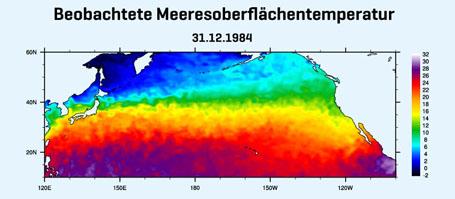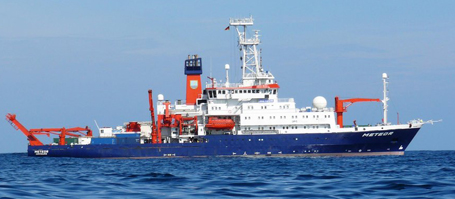Interactions between the ocean and the atmosphere generate climate variability on very different time scales up to decades or centuries. However, so far, it is not clear to what extent short-term daily fluctuations in the oceans exert a significant influence on the atmosphere and thus, must be taken into account for predictions of long-time climate variability. A new study led by scientists at GEOMAR Helmholtz Centre for Ocean Research Kiel shows that daily variations of sea surface temperature impact long-term reactions of the atmosphere on decadal timescales. Consequently, the simulation of oceanic variations with high temporal and spatial variability plays an important role for longer-term climate predictions on timescales of decades.
Climate models are designed for long-term integrations. This is only possible with high-performance computers and also requires simplifications for example compared to models used for weather forecasts. This also applies to short-term fluctuations, the " ocean weather" which is not simulated by many ocean models. Marine scientists in Kiel now studied the role of "ocean weather" on the atmosphere over the North Pacific. "Our simulations showed that the daily fluctuations in sea surface temperature, which were often regarded as insignificant, are able to influence the long temporal variability in the area of the North Pacific," says Prof. Dr. Mojib Latif, co-author of the study from GEOMAR. "The ,marine noise’ acts as a kind of catalyst. The atmosphere "feels" the slow, decadal variations of sea surface temperature only if it perceives also the rapid oceanic changes”, Latif continues. The daily fluctuations in the ocean influence in particular the low pressure systems. Prof. Latif: "The lows are in some ways the "translator" between the slow changes in the oceans and the overlying atmosphere."
"Now it is important to figure out whether this result can be transferred to other ocean areas such as the North Atlantic," says the climatologist. Furthermore, the scientist from GEOMAR hope to motivate other research groups to conduct similar simulations.
If this result is robust, this would have important implications for climate modeling in total. On one hand the oceanic components of the climate models would have to be capable to simulate "ocean weather" and on the other hand atmospheric components are required capable to resolve them. In general for both processes this is currently not the case. This could be an important key to improve decadal climate predictions in the mid-latitudes.
Original paper:
Zhou, G., M. Latif, R. J. Greatbatch, and W. Park, 2015: Atmospheric response to the North Pacific enabled by daily sea surface temperature variability, Geophys. Res. Lett., 42, doi: 10.1002/2015GL065356.
Contact:
Dr. Andreas Villwock (GEOMAR, Communication & Media), Phone: +49-431 600-2802, presse@geomar.de
…



